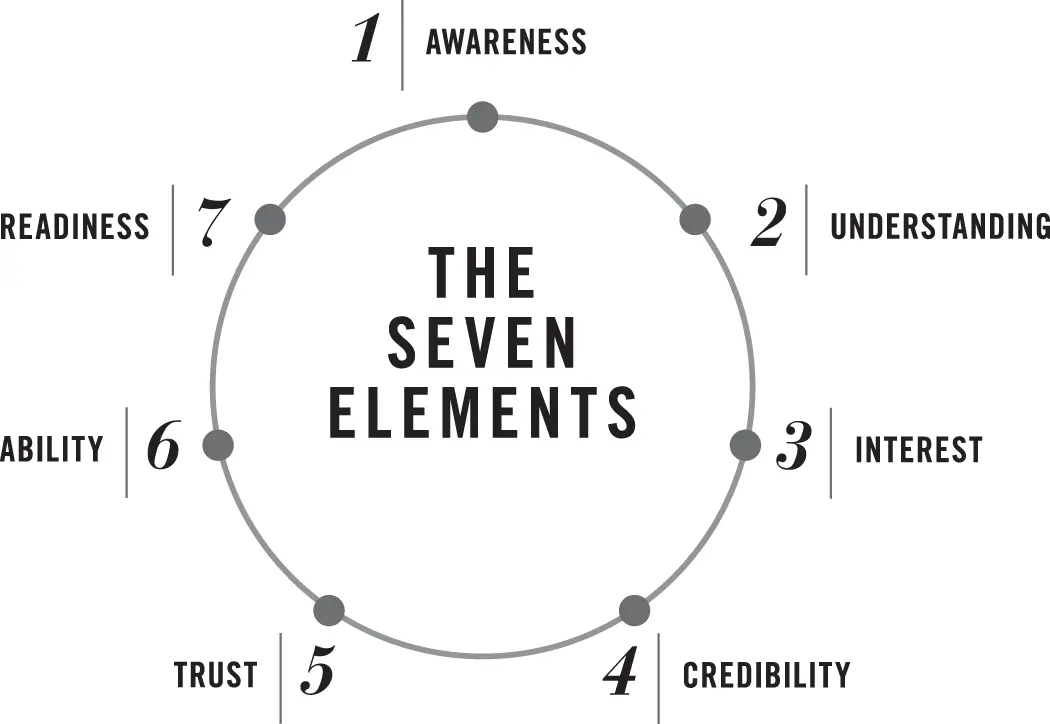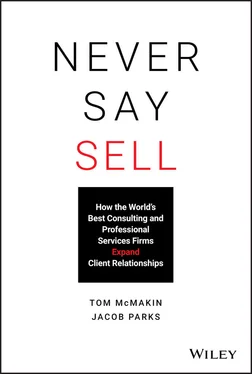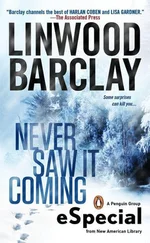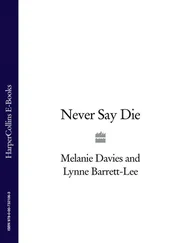In our earlier book, How Clients Buy , we discussed the seven elements that lead to success in landing new clients in expert services. Let's find out where there are cognates – and stumbling blocks – as we learn this new language of farming.
How Clients Buy unpacked the set of preconditions that have to be present before a client elects to engage with an expert services provider.
Prospective clients must:
1 Be aware of our existence.
2 Understand what we do and how we are unique.
3 Be interested in our service offering. Our services must be relevant to their goals.
4 Believe we have credibility; they must respect our work and be confident in our ability to do what we say we can do. *
5 Trust us to have their best interests at heart.
6 Have the ability to engage with us, meaning they have sufficient authority, budget, and organizational support.
7 Be ready to act. The timing must be right. Sometimes all other conditions are met but some other priority supersedes.

Mutually Exclusive and Collectively Exhaustive
In 335 BC, Athens was conquered by the Macedonians. Aristotle, then a man of 50, returned to Athens after living overseas. There, he set up a school in the Lyceum outside the walls of the city. He'd lecture in the morning, with a particular emphasis on his great love – logic. The following classic example of a categorical syllogism demonstrates how he thought about logic:
All men are mortal.
Socrates is a man.
Therefore: Socrates is mortal.
Aristotle was particularly focused on what he called “categories” since he believed thinking clearly about how elements relate to each other was the ground from which deduction grew. “Men” is a category. It has a characteristic, called “mortality.” Socrates is a member of the “men” category; therefore, it follows that Socrates participates in that category's characteristic, “mortality.” In the Organon , Aristotle wrote that for categories to be useful, they must be distinct from each other: “Of things said without any combination, each signifies either substance or quantity …” Aristotle is saying that, assuming there is no overlap in categories (that's the “without combination” part), most categories relate to each other substantively or in number.
In 1963, a full 2,298 years later, McKinsey hired Barbara Minto. She was the first woman with an MBA brought on as a professional at McKinsey. Though she only worked for the firm for 10 years, her impact is still felt. Barbara argued, giving due credit to Aristotle, that when describing what has caused a problem, or how it should be fixed, the description of the parts should be “mutually exclusive and collectively exhaustive,” what she called MECE. Though this is most commonly pronounced “mee-cee,” Barbara said it should be pronounced “meece,” like “Greece.” As she put it, “I invented it, so I get to decide how it is pronounced.”
For example, if we are asked to list competitors to Ford Motor Company, we would want to include all other car companies (e.g., Chevy, Fiat, Porsche) and not leave any out for the list to be “collectively exhaustive.” At the same time, each of the companies on the list of competitors should be completely distinct from each other, or “mutually exclusive.” Porsche is owned by the Volkswagen Group and Fiat owns Chrysler, Dodge, and Alfa Romeo; so, for the list to be MECE, we'd want to specify whether it is a list of corporations or brands. Barbara argued that when comparing apples, we need to make sure not to add in any oranges or the result will be muddled thinking.
Barbara was our inspiration when asking the question: How do clients buy expert services? Each of the seven elements is logically distinct and together they represent an accurate picture of the whole. For example, a prospect needs to understand what we do in order to engage with us. Separately, they need to be able to buy from us or all the understanding in the world won't lead to them scoping a project with our firm. And the list goes on; in order to buy, all seven elements need to be present.
Any Step Can Be the First
The Seven Elements paradigm is not a series of steps to be climbed. We can enter the set of preconditions from anywhere on the circle. Understanding what our capabilities are does not necessarily precede the need for a potential client to trust us implicitly.
For example, you might have known a woman from church for 10 years, voted for her to join the congregation's leadership council, and thanked her for writing a college recommendation for your son, without ever knowing she was an expert at integrating stand-alone accounting software plug-ins with Salesforce. You trusted her completely as a person before ever understanding what her service offering was (or that she even had one).
The opposite can be true as well. You might have always known there was a franchise attorney the next town over named Frank, but you've never known whether he was any good. Then one day, you're having coffee with the CEO of a housecleaning franchise at the International Franchise Association Annual Convention in Las Vegas, and he raves about Frank. You trust this CEO's opinion. Hearing his description of the excellent work Frank did for them, you can feel your trust in Frank grow, as a potential representative of your own interests. You may have understood what Frank's services were for the past decade, but until now, you wouldn't have known he was the right one to trust with your business.
The seven elements are a set of preconditions that must be present before clients engage with a new expert services provider.
How Do the Seven Elements Apply?
Using the seven elements as our guide, engaging more deeply with an existing client should be easy.
1 Clients are already aware of our firm.
2 Clients understand what our firm does.
3 Clients have an interest in us because we're already helping them on a project.
4 Clients respect our work, meaning we've earned credibility as they know we'll get the job done.
5 Clients trust us because in ways large and small, we have demonstrated we have their back.
You should only have to wait until:
They have budget and are able to pull the trigger on new projects.
They have support organizationally and are ready to pull the trigger.
Sadly, it's not that easy. You pole-vaulted over the high bar once to win the work, but now you're running 1,000-meter hurdles.
If you work for a client, they know who you are. That's self-evident. Maybe you have been working shoulder-to-shoulder with them for the past 36 months, building a hiring, training, and retention model that will support their growing workforce needs. They know you. You've gone out to Ruth Chris's for fancy steaks that cost more than an upgrade on United. You've eaten mushroom and sausage pizza late at night as you worked to get a project phase done before your client had a status presentation due. You've visited them in their shop, and they have visited you. You've swapped Netflix suggestions. You know each other.
But, do your buyer's colleagues know you? The answer, probably, is no. We all run into this. Our buyer's colleagues might have heard of our firm, but, just as possible, they have a vague impression that our buyer is simply “doing good work on that initiative” on his own. Although we may feel like ‘insiders,’ we may still be completely unknown to others in the company.
Читать дальше













